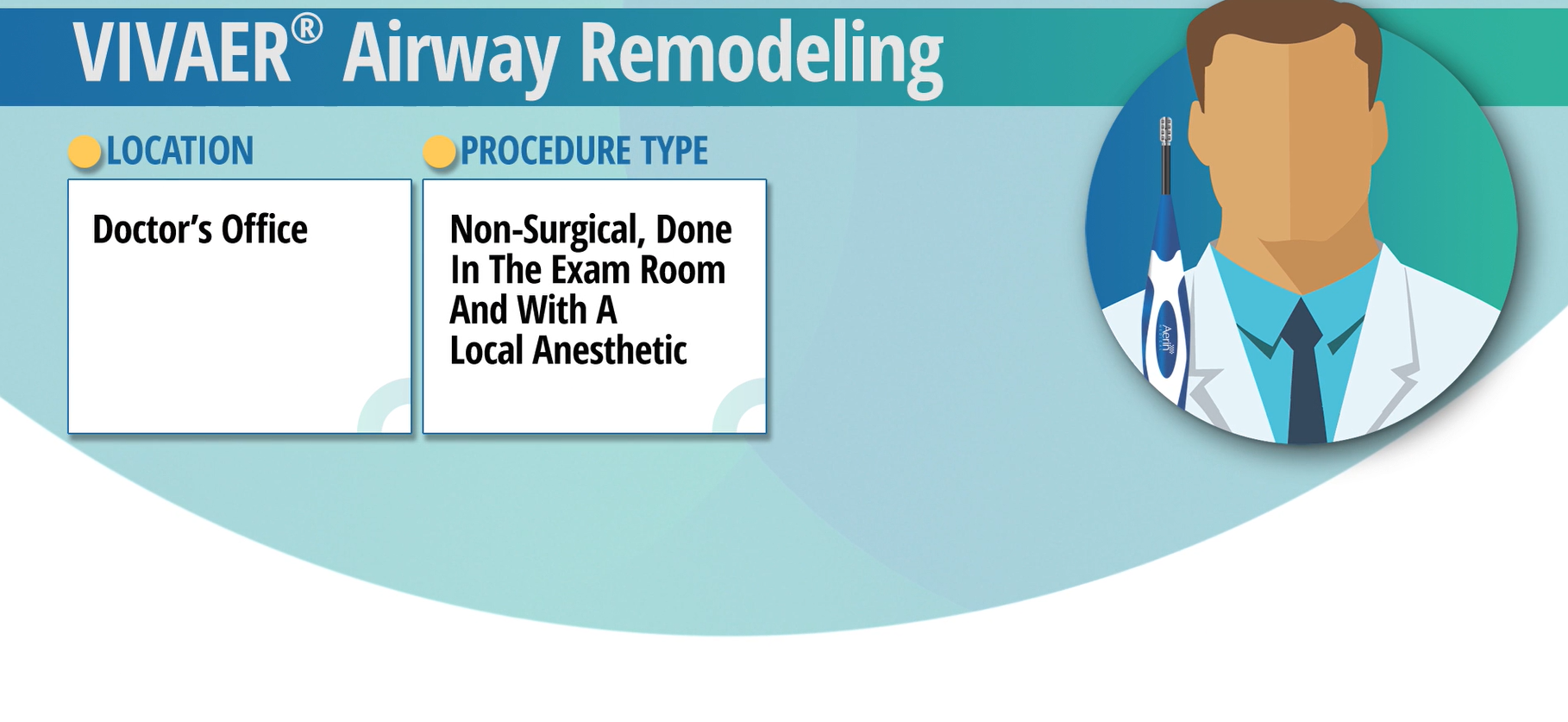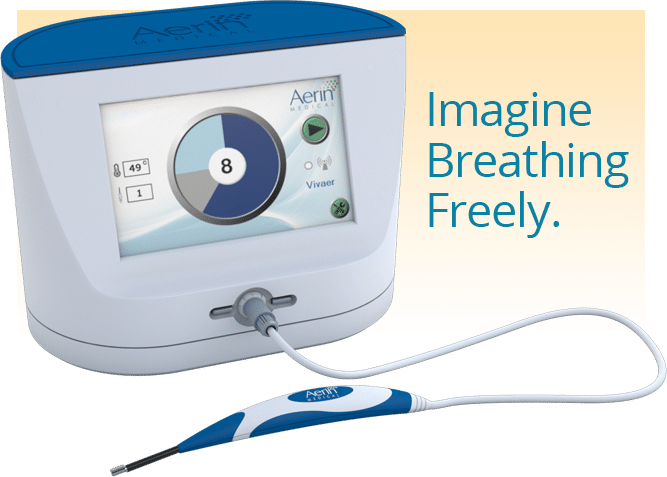Vivaer Nasal Remodeling Procedure
Breathe Easy, Minimally Invasive Airway Transformation!
Vivaer Nasal Airway Remodeling Procedure
Millions of individuals in the United States are living with conditions that cause nasal congestion or obstruct their nasal passages in some way. This often makes it hard to breathe completely through their nose. If the condition is severe enough, treatment may involve painful, invasive surgery requiring general anesthesia.
However, there's now a new technology, one that's virtually painless and non-invasive, that a clinical trial found to show promise. This technology is the Vivaer Nasal Airway Remodeling procedure.
The study recruited 31 participants who were between the ages of 18 and 75 who were suffering with chronic nasal obstruction caused by the shape of their nasal valve. These participants also experienced success with temporary measures of opening their nasal cavity like stents and nasal strips, but where steroid medicine didn’t help. The study excluded those with
- Chronic sinusitis
- Severe septal deviation
- Prior nasal valve surgery
- Polyps
One goal of the study was to better understand how the Vivaer technology changes the flow of air through the nose to help individuals feel satisfied with their nasal breathing.
What is the Vivaer Nasal Airway Remodeling Procedure?
The doctor performs the Vivaer procedure right in their office and reshapes your nasal tissues gently, helping you to breathe better. They use a small hand-held device that uses controlled radiofrequency energy to reshape your nose tissues without any incisions, helping improve airflow.
Until recently, the standard treatments for nasal obstructions were:
- At-home treatments: Internal nasal dilators, external breathing strips and sprays are home remedies people still use today and that you may have tried. But, these never quite fix the issue and don't offer long-term relief from your symptoms.
- Medications: These could include steroids, antihistamines and antibiotics.
- Nasal surgery: Traditional nasal surgery involved pain, less-than-spectacular outcome and a long recovery time. Unfortunately, surgery was the only course of treatment for individuals with advanced nasal issues. Although surgery is effective in many cases, it doesn't always take care of the issues of nasal obstruction due to narrow nasal valves.
Today, with the Vivaer procedure, you have another option available. Your nasal valve area (often the main region involved in nasal blockage) can be opened up during your brief office visit.
interested in learning more about vivaer?
Click the image below to request an appointment today at one of our Houston Ear, Nose, Throat locations throughout Houston!
Reasons and Indications for the Vivaer Nasal Airway Remodeling Procedure
Below are some Vivaer indications.
Nasal Valve Narrowing
Your nasal valve area is in your nasal passage and is a triangular-shaped area made up of:
- The septum: A ridge of cartilage you have that's made of tissue and bone and sits between your nostrils.
- The lateral wall: Tissue that forms the outer wall inside your nose.
- The turbinates: The small shell-shaped tissue areas inside your nasal passages that humidify, cleanse and direct the air that enters your nostrils.
Any narrowing or weakness of this nasal valve, which is already narrow, can lead to decreased airflow and severe congestion, making it hard to breathe through your nose.
Nasal Obstruction
There are numerous causes of nasal obstruction, including:
- Enlarged turbinates
- Deviated nasal septum
- Enlarged adenoids
- Nasal congestion
- Nasal polyps
- Tumors
Nasal obstruction is typically caused by nasal tissue swelling or an anatomical blockage that results in nasal cavity narrowing and congested passages. It can result in snoring, sleeping disorders and obstructive sleep apnea (OSA).
Your body is made to breathe from your nose. When congestion hinders nasal breathing, your body forces you to start breathing through your mouth, which isn't the best way of passing air into your lungs. Breathing through the mouth creates vibrating or a greater amount of negative pressure behind your uvula and soft palate which leads to snoring during sleep.
Snoring
At least 45 percent of normal adults occasionally snore and 25 percent snore habitually. Men and individuals who are overweight have a higher incidence of sleep problems and snoring. And, their issues tend to worsen with age. Snoring could be an indication of nasal obstruction and shouldn't be taken lightly.
Impaired Sleep
The University of Wisconsin Sleep and Respiratory Research Group conducted a study that found nasal obstruction caused an increase in sleep disordered breathing events like apneas (pauses in breathing), snoring and hypopneas (events of very shallow breathing).The participants in the study with nighttime rhinitis reported an increase in:
- Excessive daytime sleepiness
- Habitual snoring
- Chronic non-restorative sleep
Sleeping on your back (supine position) can also increase nasal passage congestion, making it more difficult to breathe and increasing snoring.
Nasal congestion-related impaired sleep can pose other risks such as:
- Increased risk of accidents
- Fatigue
- Negatively affected quality of life
- Alteration in mood or depression
- Decrease in productivity
If you're experiencing disruptive snoring and chronic nasal congestion, you could be at risk for OSA which is a potentially harmful condition marked by events of cessation or pauses in breathing because of an obstruction.
Enjoying life is not easy when your nose is always blocked. Getting a good night's sleep is almost impossible, intensive exercise is not possible, you feel like your health is at stake and your attitude is affected.
Some things that could cause temporary nasal congestion are:
- Allergic rhinitis (allergies like hay fever)
- Chronic sinusitis
- Cold or flu
- Environmental irritants like dust or smoke
- Certain medicines like high blood pressure medication
- Sinus infection
Common anatomical factors that could contribute to nasal congestion or obstruction are:
- Nasal polyps (benign growths inside your nasal cavity)
- Deviated nasal septum (crooked nose cartilage that blocks the airway)
- Enlarged adenoids (blocks the back of your nasal passage)
- Enlarged turbinates (bony structures inside your nasal cavity)
- Nasal tumors (cancerous or benign)
Regardless of the cause of your nasal congestion or blockage, it's not comfortable and when you're experiencing it regularly, it can often hinder your quality of life.
Benefits of the Vivaer Procedure
Many individuals notice an immediate improvement in their nasal breathing after the Vivaer procedure is completed.
Some Vivaer benefits are:
- Non-invasive technology: Vivaer is proven technology that treats your nasal congestion effectively by reshaping the tissues of your nose gently, making easier breathing possible.
- Clinically proven results: Studies like the one above show significant improvements (similar to more invasive surgeries) in patients experiencing symptoms of nasal obstruction.
- Procedure performed in-office: Your treatment is easy and performed in the doctor's office using a local anesthetic so you can go home the same day and return to your normal activities immediately.
Other benefits of the Vivaer treatment include:
- Minimal discomfort
- Non-invasive/no-incisions
- Convenient (performed in doctor's office)
- Quick (the entire treatment takes only around 15 minutes)
- No implants
- Highly effective
- Safe
- No exterior nose changes
- Little to no restrictions after your treatment
- Quick recovery time
About the Vivaer Procedure
The Vivaer treatment uses a device that applies low-temperature radio-frequency energy for contracting and tightening the cartilage and tissue in your nose. It reshapes your nasal valve area, allowing for better airflow. You'll experience a noticeable improvement in your nasal breathing immediately.
Before the doctor performs the nasal airway modeling procedure, they might have computed tomography (CT) scans taken to show them exactly how the blockage is affecting the airflow through your nasal cavity. There's no anesthesia needed and no complications, sustained recovery period or risks. There's also no huge hospital bills either as you'd receive if you were undergoing invasive surgery under general anesthesia.
Before your procedure, the doctor will evaluate your nasal airway obstruction symptoms. They'll perform the Cottles maneuver where they'll place a narrow tool in your nose to lift tissue inside your nasal valve area gently, simulating the changes the Vivaer procedure might create.
Recovery from the Vivaer Nasal Airway Remodeling Procedure
Because no cutting or incisions are involved with the Vivaer Nasal Airway Remodeling Procedure, recovery is quick, and you’ll likely experience a noticeable improvement in your nasal breathing right away.
You might experience some tenderness and inflammation at the site of treatment during your first few days after your procedure. If you have to blow your nose, be sure you do it gently and don't manipulate or pinch the treatment area.
During your first few weeks after your treatment, you might experience some crusting and congestion at the site of treatment. Our Houston ENT & Allergy Services doctor might suggest you apply an ointment to this area or use certain nasal rinses or sprays.
Talk to Houston ENT and Allergy Services About Vivaer Nasal Airway Remodeling
Contact Houston ENT & Allergy Services for a Vivaer Nasal Airway Remodeling procedure consultation to discuss whether the Vivaer Nasal Airway Remodeling Procedure is right for you, to see if you're a good candidate, and to discuss the Vivaer Procedure cost. Write down all the questions you have and bring them with you. This is the time to ask them. Our doctor will go over the procedure with you in more detail during your consultation.
ADDITIONAL INFORMATION ON Nasal Breathing Congestion, blockage, and problems in HOUSTON, TEXAS
DOES YOUR NOSE WHISTLE WHEN YOU BREATHE?
NASAL CONGESTION/BLOCKAGE AND THE VIVAER PROCEDURE IN HOUSTON TEXAS
WHAT IS A DEVIATED NASAL SEPTUM? (SIGNS, SYMPTOMS, AND CAUSES)
CLARIFIX: THE RUNNY NOSE/CHRONIC RHINITIS TREATMENT IN HOUSTON
RUNNY NOSE (CHRONIC RHINITIS): DEFINITION, SYMPTOMS, AND CAUSES
WHAT IS A SEPTOPLASTY? (INDICATIONS, REASONS, AND PROCEDURE)


